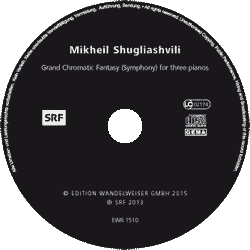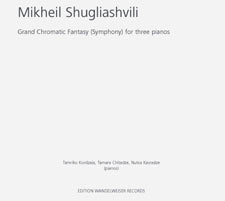EDITION WANDELWEISER RECORDS
> CD catalogue
>> mikheil shugliashvili
_____________________________________________________________________
<< >>
Mikheil Shugliashvili
Grand Chromatic Fantasy (Symphony) for three pianos
| order reference: medium: composer: performer: |
EWR 1510 CD Mikheil Shugliashvili Tamriko Kordzaia, Tamara Chitadze and Nutsa Kasradze (pianos) |
 |
 |
>> the wire >> dustedmagazine >> the guardian >> br-klassik Mikheil Shugliashvili (1941-1996) Grand Chromatic Fantasy (Symphony) for three pianos (1974 / 1976-78) Tamriko Kordzaia, Tamara Chitadze and Nutsa Kasradze (pianos) Sound-time cubes He apparently loved Bach, but which musician doesn’t? Apart from that only sparse biographical data has been passed on. Encyclopedias don’t know about him, internet searches produce only very few results: Mikheil Shugliashvili, born 1941 in Tbilisi, Georgia, passed away 1996, in Georgia. He started making music at the age of 10, playing cello. It was already too late to start the piano. Soon he was recommended to study at the Moscow Gnessin Institute, again cello. There was no composition class for teenagers. At the age of 15 he returned to Tbilisi, to finally start studying composition with Andria Balanchiwadze. He flunked out of school twice-his music was judged to be cacophonous. A person like this however finds his own way. In the sixties and seventies, his most productive years, his works ranged from solo to large orchestra. Although he was supported by some faithful friends and performers, many of his works were never performed, as is the case with the piece on this CD, the Grand Chromatic Fantasy (Symphony) for three pianos from 1974/1976-78 (two contradicting dates exist, possibly suggesting an extended composition period). The piece has not been published. It only received its premiere on October 4, 2013 in Tbilisi by Tamriko Kordzaia, Tamara Chitadze and Nutsa Kasradze. Three weeks later they performed it again in Zürich. It was nothing less than an event, albeit a late one. In the eighties, far off from the official music world, Shugliashvili worked mainly as a music teacher. Here too, little wonder, he developed his own method and established a small private school. In the nineties he founded a studio for computer music within the Kwali Film Studios in Tbilisi, for which he had some new ideas. But they could not longer be realized. From this distance the Grand Chromatic Fantasy (Symphony) now joins the important minimalist works of the seventies. But in advance of any comparison of this music (processes unfolding in time through repetition and layering) with the music of Steve Reich, Philip Glass, Arvo Pärt or Simeon ten Holt, its unique and almost forbidding character instantly appe- ars. In the course of nearly an hour a singular erratic block comes into existence, like the best we know from Morton Feldman or Galina Ustwolskaja. And yet the sound material is not at all unfamiliar. It was – even in those days – hardly novel. What Shugliashvili did with it, however, goes far beyond the usual, and far beyond Middle Europe. The piece starts with straightforward descending chromatic scales. Gradually they expand downwards, overlapping, here and there with pedal held down, allowing an aura to arise, and then thinning out again. And thus it descends for five minutes. Then, similarly, it ascends for a little while. Soon it goes both ways simultaneously, growing denser and denser. After a quarter of an hour this leads to an intense climax, erupting into fierce clusters. A long rhythmical passage follows, played by knocking on the keyboard lids. Again, cascades of scales or repetitions of muted tones. At times the elements get combined; iridescent fields, swarms of sound emerge ... Apparently this composer understood already very early how sound material can be emptied, hollowed out by repetition, which allowed him to find and invent new potentials and to build new architectures of time. Thus we are guided through the minutes by the always rigorous composition, sometimes into the light, at other times into darkness; through garlands and near standstills. Because all this happens on three pianos, movement and stillness are staggered in space; cubes of sound and time come about. Since the pedal is mostly down, the sound fields ring for a very long time. Shugliashvili’s music is expansive, but not relaxed, let alone lacking tension. Rather it is a sharply contoured constructive painting of magnificent simplicity and intensity. But where does this gargantuan toccata lead us? It actually has a destination: after a good three quarters of an hour the piece eventually lands where the title already directed our thoughts: Bach’s Chromatic Fantasy (though without its Fugue). Its well-known passages burst ferociously into an aleatoric counterpoint of sorts. They pause, then run around each other, sounding almost like an organ. And importantly: we are indeed in a „concert church”, a sacred art space. After almost an hour the work ends with powerful low range key drumming, ebbing away over a long period of time. Or is it bells? Thomas Meyer (translation: Antoine Beuger, Michael Pisaro) About the performers: Tamriko Kordzaia, Tamara Chitadze and Nutsa Kasradze all come from Georgia and have studied at different times at the Tbilisi Conservatory, partly with the same teachers – Nodar Gabunia, Nana Khubutia, Tengiz Amirejibi and Svetlana Korsantia. After the opening of the borders in the nineties many Georgian artists decided to leave the country. Amongst them, Tamriko Kordzaia and Tamara Chitadze went to Switzerland, more precisely at the Winterthur Conservatory, where they studied with Hans-Jürg Strub. Today, Kordzaia and Chitadze are still living in Switzerland, Kasradze in Georgia. All three of them have won international competitions and, as soloists and chamber musicians, maintain a broad repertoire from classical to contemporary music. |